Main menu
Common skin conditions

NEWS
Join DermNet PRO
Read more
Quick links
Dermatitis — extra information
Dermatitis
Authors: Dr Ian Coulson, Consultant Dermatologist, Burnley, Lancashire, UK. April 2022. Previous author: Dr Amanda Oakley, Dermatologist, New Zealand, 1997. Copy edited by Gus Mitchell.
Introduction
Demographics
Clinical features
Variation in skin types
Types
Differential diagnosis
Investigation
Treatment
E-lecture
What is dermatitis?
Dermatitis refers to a group of itchy inflammatory conditions characterised by epidermal changes.
Dermatitis can be classified in a variety of ways. It may be classified by:
- Cause eg, allergic contact dermatitis, photosensitive dermatitis
- Clinical appearance eg, discoid dermatitis, hyperkeratotic dermatitis, and pompholyx
- Site of predilection eg, hand dermatitis, eyelid dermatitis, or lower leg dermatitis.
In many cases, various factors may all act as underlying triggers together (allergic, irritant, and endogenous factors, especially in hand dermatitis).
The terms dermatitis and eczema are often used interchangeably. All eczema is a dermatitis, but not all dermatitis is eczema.
- Dermatitis, strictly speaking, includes any cause of skin inflammation affecting the epidermis.
- Eczema is derived from the Greek word for “to boil or bubble over”, which pathologically manifests as oedema within the epidermis (called spongiosis).
The term dermatitis is sometimes mistakenly attributed to mean an eczema induced by an occupational factor; this is erroneous.
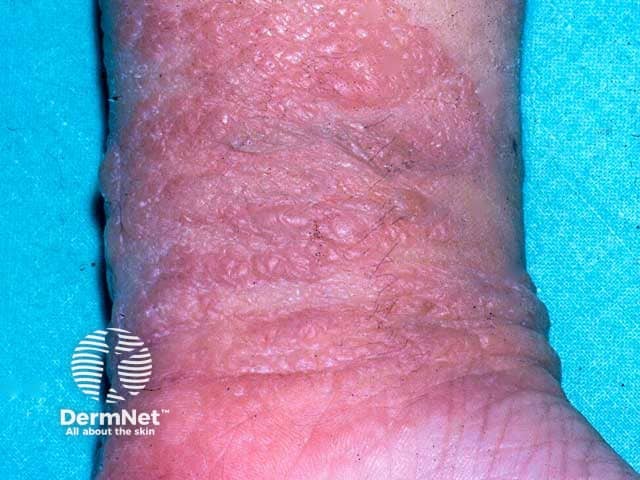
Acute weepy contact dermatitis due to sticking plaster allergy

Allergic contact dermatitis due to nickel in the sides of her spectacle frame

Gravitational eczema compounded by a contact allergy to a bandage constituent
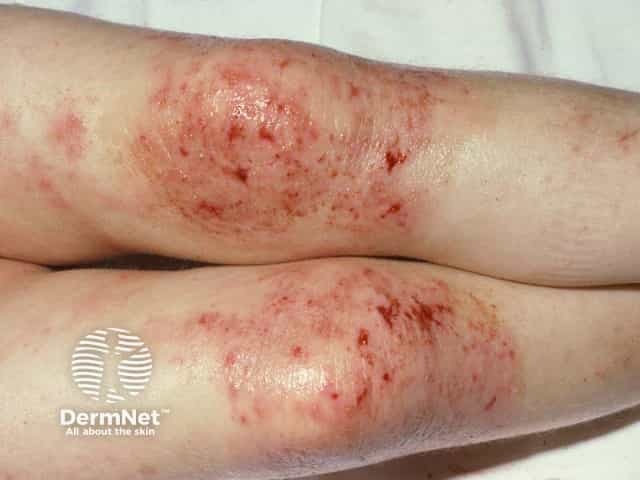
Excoriated acute eczema on the extensor aspects of the knees (reverse pattern)
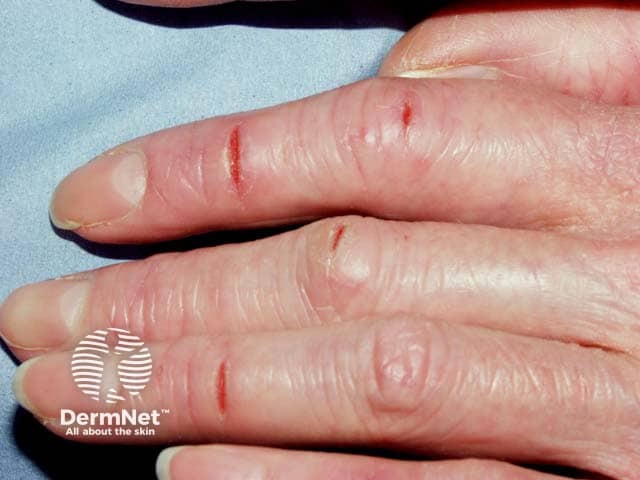
Fissuring over the knuckles in atopic dorsal hand eczema
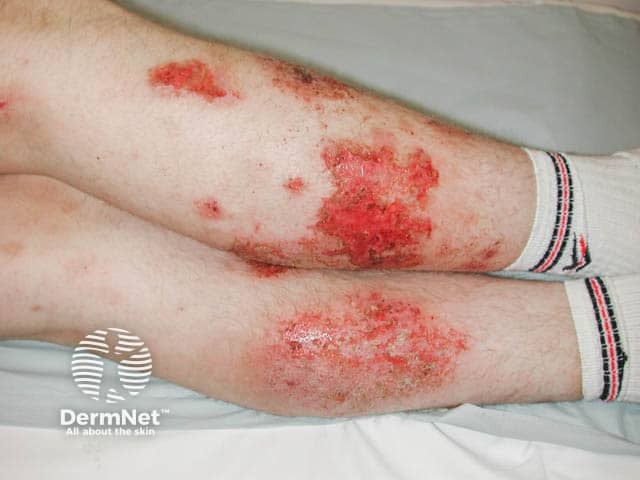
Weepy lesions of discoid eczema on the legs
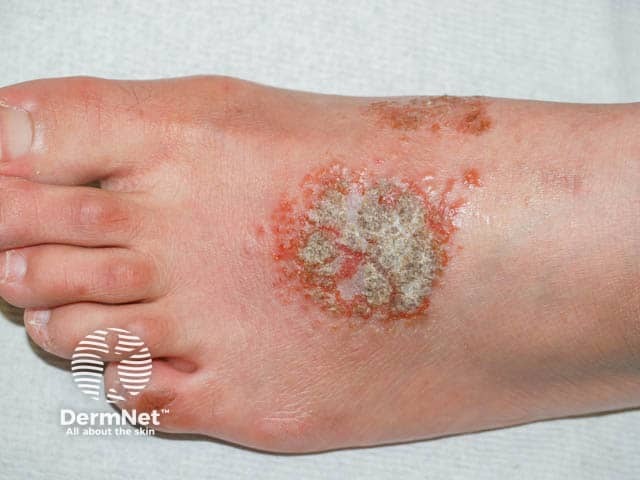
Weepy and impetigenised discoid eczema on the foot
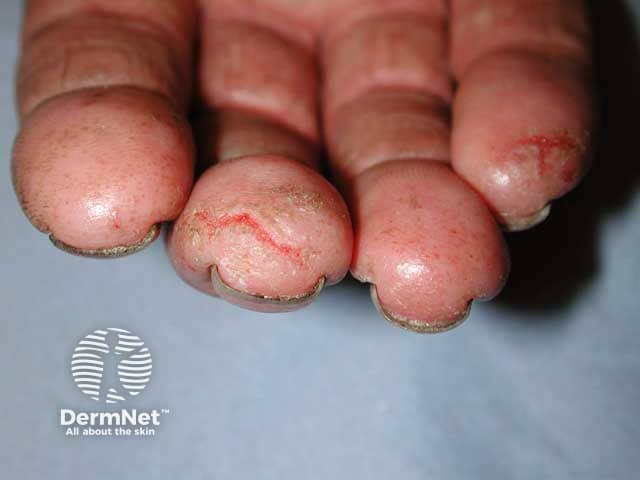
Fissuring, hyperkeratosis and vesiculation in chronic fingertip dermatitis

Discoid pattern of eczema on the dorsal hands
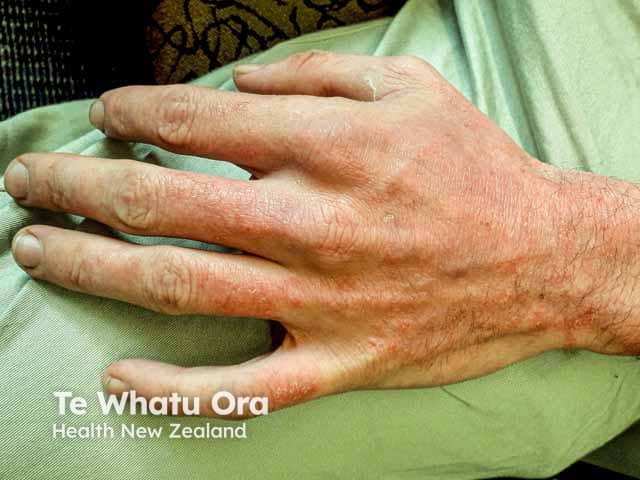
Hand eczema on the back of the hand - mixture of irritant factors in this atopic person

Hypopigmentation and fine scale on the cheeks in pityriasis alba
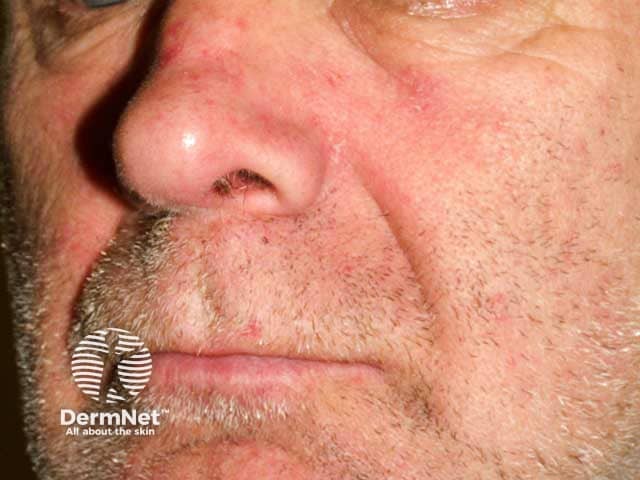
Cheek and nasolabial fold redness and scaling in seborrhoeic dermatitis
Who gets dermatitis?
Dermatitis is common, affecting about one in every five persons at some stage in their life.
Different types of dermatitis are more frequent at different stages of life, for example:
- Atopic dermatitis and pityriasis alba are more common in children
- Hand eczema is more common in young and middle-aged adults
- Venous or gravitational eczema, asteatotic dermatitis, and nummular eczema are more common in middle and older age groups.
There are no consistent racial factors influencing disease frequency.
What are the clinical features of dermatitis?
Dermatitis may be either acute or chronic, and although the mechanism by which the dermatitis develops may be the same, the appearances may be starkly different.
- Acute dermatitis will show redness or swelling, papulation, vesiculation, oozing and weeping, and even blistering.
- Chronic eczema will show skin thickening with accentuation of the skin creases, hyperkeratosis, scaling, fissuring, excoriation, and hyperpigmentation.
- Subacute dermatitis will show features of both.
How do the clinical features vary in different racial groups?
Redness may be more difficult to appreciate in darker skin types.
Post-inflammatory hypo- and hyperpigmentation are more frequent in darker skin types.
What are the types of dermatitis?
Exogenous dermatitis is the result of an external factor or insult that induces skin inflammation. Common causes include:
- Allergic contact dermatitis — due to immune sensitisation of an individual to an allergen, often at even low concentration, such as nickel, hair dye, rubber, or perfumes; identified by patch testing.
- Irritant contact dermatitis — will occur in anyone exposed to an irritant at sufficient concentration for long enough; irritants include soaps, detergents, organic solvents, degreasing agents, abrasives, desiccants, dust, urine, and even water
- Photosensitive dermatitis — triggered by light or UV radiation
- Post-traumatic dermatitis — due to physical injuries such as abrasions, burns, or surgery (eg, autonomic denervation dermatitis)
- Dermatitis induced by local skin infections such as bacterial, fungal, and viral e.g. molluscum contagiosum and HTLV-1 disease
- Drug-induced dermatitis.
Endogenous dermatitis occurs because of often ill-understood internal factors. Common types include:
- Atopic dermatitis — a common form of dermatitis occurring in children and adults, and often occurring in families with a background of asthma and hay fever
- Seborrhoeic dermatitis — common chronic eczema affecting the face, scalp, ears and major flexures, due to a reaction to yeasts that colonise the skin
- Discoid (nummular) dermatitis — coin-shaped patches of dermatitis usually affecting the limbs
- Lichen simplex — chronic dermatitis that thickens due to perpetual scratching
- Pityriasis alba — pale patches of dermatitis affecting the cheeks
- Hand dermatitis — internal, external irritants and allergic factors may all play a part even in a single individual
- Eyelid dermatitis — again, often of mixed cause
- Otitis externa — dermatitis affecting the ear canal and the pinna
- Venous or gravitational dermatitis — dermatitis due to malfunction of the lower leg vein valves
- Juvenile plantar dermatitis — a glazed and fissured forefoot eczema occurring in children
- Metabolic dermatitis — seen in some nutritional and endocrine disorders
- Chronic superficial scaly dermatitis — finger-shaped patches of eczema occurring on the trunk
- Asteatotic dermatitis — crazy-paving shaped dermatitis due to degreasing of the skin from excessive bathing and soap use on the legs in the elderly
- Halo dermatitis or Meyerson naevus — this can surround a benign mole
- Erythrodermic dermatitis — severe dermatitis when more than 80% of the skin is affected.
What is the differential diagnosis of dermatitis?
- Bacterial infections — impetigo, erythrasma
- Fungal infections
- Connective tissue diseases — lupus erythematosus and dermatomyositis
- Rosacea
- Blistering diseases — bullous pemphigoid
- Skin tumours — Bowen disease, superficial basal cell carcinomas
- Cutaneous T-cell lymphoma.
How is dermatitis investigated?
A detailed history and examination may be all that is required to make an accurate diagnosis.
The following investigations may sometimes be needed:
- Skin scraping to exclude a fungal infection mimicking a dermatitis
- Skin swab looking for bacterial or viral superadded infection
- Patch testing to identify contact allergens
- Light testing if a photosensitive dermatitis is considered
- Skin biopsy to exclude mimics of dermatitis
- Blood tests — IgE (usually elevated in atopic dermatitis), thyroid function (in some hand dermatitis and asteatotic dermatitis).
How is dermatitis treated?
General principles are covered here. Specific management of specific types of dermatitis are detailed on the relevant pages.
- Potential allergen identification and avoidance — made on the basis of history e.g. hobbies, products used, and occupation. A patch test will confirm.
- Potential irritant identification and avoidance — avoid soaps, shower gels, dust, organic solvents, and drying/desiccating agents.
- Protect the skin with personal protective equipment — especially hand dermatitis, by the use of cotton gloves for dry work, and cotton with an occlusive glove appropriate to the suspected allergen or irritant.
Topical therapies
- Emollients — both in place of soap, after bathing or washing, and at any time if the skin feels dry.
- Potassium permanganate soaks — useful for drying up weepy exudative or blistering acute eczema.
- Paste bandages — useful to help topical steroids penetrate the skin, soothe, and reduce skin trauma from scratching.
-
Topical steroids — generally use an ointment if the skin is dry, and a cream if it is wet and weepy.
- Most work just as well if applied only once daily.
- Help reduce skin inflammation that causes the eczema, and should be applied where the skin is inflamed (red and itchy).
- Potent products are often used for 7–14 days, then the frequency of application is reduced to alternate days, then twice weekly, and the potency of the steroid reduced.
- Twice weekly steroid treatment is often recommended to prevent disease relapse, and prevent flare-ups for extended periods.
- Topical anti-inflammatory agents
- Calcineurin inhibitors such as pimecrolimus and tacrolimus suppress eczema and do not have the long-term side effects of potent steroids, particularly for the face.
- Newer small molecules such as JAK inhibitors (ruxolitinib) are either approved or being developed for the treatment of dermatitis.
Physical therapies
- Ultraviolet B and Psoralens UVA (PUVA) may be valuable for recalcitrant atopic and discoid dermatitis.
Systemic agents
- Antihistamines — to suppress the itch of eczema, a sedating antihistamine, rather than a non-sedating agent is generally needed.
- Antibiotics and antivirals — should be considered if the eczema is super-infected with bacteria (Staphylococcus) and herpes simplex.
- Immunosuppressive therapies — less than 2% of chronic eczema sufferers will fail to be adequately controlled with the above therapies. Agents that reduce the overactive immune response seen in dermatitis may help. Methotrexate, azathioprine, and ciclosporin are the agents usually considered.
- Biological therapies — antibody treatments that specifically block the key mediators of inflammation in dermatitis (cytokines) are in use and in active development for severe dermatitis. These injection treatments include dupilumab, tralokinumab, lebrikizumab, and nemolizumab.
- Oral small molecules — baricitinib, upadacitinib, and abrocitanib either are licensed or are being considered for licence and use in moderate/severe atopic dermatitis in many countries. These agents block the JAK/STAT pathways that in turn regulate cytokine production.
On Dermnet
- Atopic dermatitis
- Nummular dermatitis
- Seborrhoeic dermatitis
- Hand dermatitis
- Pompholyx
- Irritant contact dermatitis
- Incontinence associated dermatitis
- Allergic contact dermatitis
- Pityriasis alba
- Chronic superficial scaly dermatitis
- Juvenile plantar dermatitis
- Autonomic denervation dermatitis
- Blistering skin condition
- Topical steroids
- Emollients
- Patch testing
- Paste bandages
- Potassium permanganate
Other websites
- Eczema — Medline Plus
- Allergy New Zealand: local support group
- Eczema Association of New Zealand
- National Eczema Association for Science and Education: an American patient support organisation
- Patient information: Contact Dermatitis (The Basics) — UpToDate (for subscribers)
- Eczema/skin reactions — AHA! Swiss Allergy Centre
- Eczema — American Academy of Dermatology
